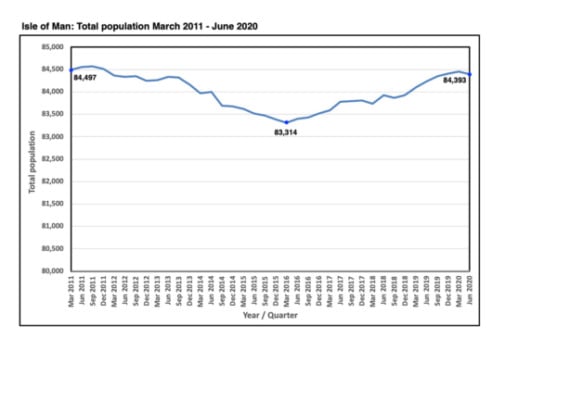The island’s population appears to have fallen again - but the number of over-65s continues to increase.
Estimates obtained by author of the Manx Population Atlas, Paul Craine, suggest that the total population dropped by 60 to 84,393 between March and June this year.
The 2016 the census revealed that the population had fallen by 1,183 from 84,497 to 83,314 since 2011.
Latest government estimates show that, although the population has risen since 2016, it has still not recovered to the 2011 level after almost 10 years.
And while the total Isle of Man estimated population may have fallen by 60 people between March and June, the number of people aged 65 and over has grown by a further 36.
The number of over-65s is now 18,293 (21.7%). In 2011, the 65 and over group contained fewer than 15,000 people (17.7%).
Mr Craine said: ’Whilst the older population grows, the estimated size of the population aged under 65 has fallen by almost 100.
’This may not indicate the start of a new trend but confirms that the under-65 population has been "flat-lining" since 2016.’
Mr Craine it was a cause for concern that production of quarterly economic reports has been suspended by the government for at least 12 months.
These reports have been the only source of population figures and estimates between censuses.
Mr Craine instead made a written request to the Economic Affairs Division to secure the population figures.
He said it had seemed possible that the peak period of Covid-19 cases as well as lockdowns and border restrictions might have impacted on the island’s population.
But this appears not to have been the case.
He said: ’It is perhaps surprising that the island’s population does not yet show any clear impact of the Covid travel restrictions that have been in place since late March. However, it is clear that the population remains vulnerable to continued ageing, possible further overall decline and the net emigration of young adults.’
He said the new estimates provide evidence to support the suggestion that the so-called ’mini-boom’ in the local housing market has been driven by island residents looking for a property change rather than by inward migration.
Mr Craine said contrary to ’over-optimistic’ government projections, the population has not risen and the Strategic Plan and subsequent Area Plans now appear to be based on ’wishful conjecture rather than real evidence’.
He said the 2021 Census, now just over six months away, will be a key source of data that needs to be built into planning policy at the ’earliest opportunity’.





Comments
This article has no comments yet. Be the first to leave a comment.